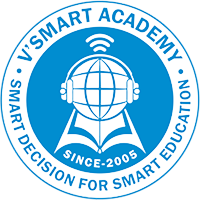CA Law & DT Preparation Strategy for Jan 2026 by Shubham Singhal
Law and Direct Tax consistently rank as the two most challenging subjects for CA students. Students often struggle with lengthy provisions, complex amendments, and the art of scoring high marks in these papers.
The problem isn’t just about studying hard. Most students memorize without understanding the logic. They focus on quantity over quality. This approach leads to confusion during exams and mediocre scores.
Shubham Singhal, renowned faculty at Vsmart Academy, has developed a proven strategy that transforms how students approach these subjects. His method focuses on conceptual clarity, strategic preparation, and practical application techniques that deliver results in Jan 2026 exams.
H2 - CA Law & DT Shubham Singhal's 3-Pillar Approach
Mastering Law and DT isn’t about memorizing everything. Success demands a smart, strategic approach that maximizes your efficiency while ensuring comprehensive coverage.
Shubham Sir’s methodology revolves around three fundamental pillars that apply to both subjects. These pillars have helped thousands of students achieve exemptions and high scores.
Pillar 1: Absolute Conceptual Clarity (Go Beyond the Books)
Understanding the ‘why’ behind every provision matters more than memorizing the ‘what’. This approach builds a solid foundation that helps you tackle any question variation.
For Law, this means diving deep into the Bare Act. Don’t just read sections—understand their purpose and application. Study the underlying business logic behind corporate provisions. Connect different sections to see the complete picture.
For Direct Tax, focus on the computation logic. Understand why specific deductions exist. Know the rationale behind different tax rates. This clarity helps you handle complex scenarios with confidence.
The ICAI study material provides comprehensive coverage, but conceptual clarity comes from questioning every provision and understanding its practical implications.
Pillar 2: Master the Amendments
Both subjects evolve continuously. CA Inter Law has specific amendments for May 2025 exams, particularly related to Companies Incorporated Outside India and changes to the Companies (Registration of Foreign Companies) Rules, 2014. These updates are critical differentiators for high scores.
For CA Final DT amendments, staying current with the latest provisions gives you a competitive edge. Changes include revisions to revenue recognition standards and new rules on cryptocurrency transactions.
Create a dedicated amendment tracking system. Update your notes regularly. Practice questions specifically covering amended provisions. This systematic approach ensures you never miss crucial updates that frequently appear in exams.
CA Inter Law amendments require special attention to corporate law changes. Focus on recent modifications to foreign company registration procedures and compliance requirements.
Pillar 3: The Art of Presentation and Writing Practice
Knowledge without proper presentation leads to average scores. Examiners evaluate your ability to communicate legal concepts clearly and structure tax computations logically.
Develop a consistent answer structure for Law papers:
- State relevant facts clearly
- Identify applicable provisions with section numbers
- Apply the law to given facts
- Conclude with clear recommendations
For Direct Tax, master the presentation of computations. Show clear step-by-step calculations. Use proper headings for different income heads. Highlight final tax liability prominently.
Regular writing practice builds speed and accuracy. Time yourself while solving past papers. Focus on improving your handwriting and answer organization.
CA Law & DT Subject-Wise Strategy: Applying the 3 Pillars
How to Study Law for CA Exams with Shubham Singhal
Focus on Keywords from the Bare Act
- Extract key terms from each section
- Use these exact terms in your answers
- Build a glossary of important legal phrases
- Practice incorporating statutory language naturally
Learn How to Remember Section Numbers
- Group related sections thematically
- Create memory aids for crucial provisions
- Focus on frequently examined sections first
- Don’t overwhelm yourself with minor provisions
Structure Your Answers Effectively
- Facts: Summarize the given scenario clearly
- Provision: State relevant sections with numbers
- Analysis: Apply the law to facts systematically
- Conclusion: Provide clear, actionable advic
Develop Your Study Plan
- Allocate 60% time to Corporate Law
- Reserve 40% for Economic Laws and other topics
- Create weekly revision schedules
- Balance new learning with regular review
Important Sections for CA Final Law
- Master fundamental corporate governance provisions
- Focus on merger and acquisition procedures
- Understand compliance and penalty sections
- Study recent amendments thoroughly
Direct Tax (DT) Preparation Tips for an Exemption
Master the Five Heads of Income
- PGBP (Profits and Gains from Business and Profession) deserves maximum attention
- Understand salary computation intricacies
- Practice house property calculations extensively
- Master capital gains scenarios and exemptions
- Study other sources comprehensively
Focus on Complex Provisions
- TDS/TCS provisions require thorough practice
- Advance Tax calculations appear frequently
- Set-off and carry-forward rules need clarity
- Understand assessment procedures completely
Create Amendment Logs
- Maintain separate files for all amendments
- Note the effective dates for each change
- Practice questions covering amended provisions
- Update your revision notes regularly
Aim for Exemption Standards
- Target 75+ marks consistently in practice
- Master both practical computations and theory
- Develop speed in calculation-heavy questions
- Build confidence through regular mock tests
Direct Tax Revision Plan
- First revision: Focus on concept clarity
- Second revision: Emphasize problem-solving
- Third revision: Build speed and accuracy
- Final week: Quick formula and amendment review
CA Law & DT Revision & Practice Plan
CA Law & DT Mock Tests (RTPs & MTPs)
Revision Test Papers (RTPs) from ICAI are non-negotiable practice tools. They reveal the exact exam pattern and help identify your knowledge gaps before the actual attempt.
Start solving RTPs at least 2 months before your exam. Create exam-like conditions at home. Switch off your phone. Set a timer. Use the same pen you’ll carry to the exam hall.
Mock Test Papers (MTPs) simulate actual exam pressure. Your performance here predicts your real exam scores. Time yourself strictly, 3 hours for each paper without any extensions.
After each mock test, spend equal time analyzing your performance. Check which topics consumed the maximum time. Identify silly mistakes. Note areas where you lost marks due to poor presentation.
Strategic Mock Test Approach:
- Solve at least 5 RTPs and 3 MTPs for each subject
- Take one mock test weekly during the last 2 months
- Review answers within 24 hours of attempting
- Create error logs to track recurring mistakes
- Compare your answers with the suggested solutions
- Focus on time management patterns across attempts
Understand examiner expectations through marking schemes. ICAI provides detailed evaluation criteria. Study how marks are allocated for different answer components.
CA Law & DT Last 3 Months Revision Timeline Schedule
The last 3 months demand a structured revision approach. Most toppers complete at least 3 comprehensive revisions before their final attempt.
First Revision: Concept Reinforcement (2.5 months before exam)
- Review all major concepts thoroughly
- Clarify doubts from your initial learning phase
- Update notes with recent amendments and notifications
- Ensure complete syllabus coverage without any gaps
- Create quick reference charts for complex topics
- Build a strong conceptual foundation before moving to the application
Second Revision: Application Focus (1.5 months before exam)
- Solve diverse problem sets from different sources
- Practice writing answers extensively under timed conditions
- Focus on application-based questions and case studies
- Build confidence in handling complex practical scenarios
- Master the art of connecting theory with real-world applications
- Develop your unique answer presentation style
Third Revision: Speed and Accuracy (3 weeks before exam)
- Focus exclusively on frequently asked topics
- Practice quick recall techniques for section numbers
- Polish your presentation skills and handwriting
- Fine-tune time management strategies for each paper
- Solve the previous 5 years’ question papers under strict timing
- Perfect your exam day strategy and question selection approach
The Final Week: Quick Review Mode
- Revise only your personal notes and charts
- Practice writing key section numbers and formulas
- Review the amendment summary one final time
- Avoid learning anything new to prevent confusion
- Focus on maintaining confidence and exam readiness
Shubham Singhal CA Law & DT Law Marathon
This intensive program addresses the unique challenges of Law paper preparation in the final weeks.
Revision CA Inter Law CA Shubham Singhal (AIR 4) Jan'26 & May'26
What Makes It Special:
- Intensive 15-day revision sessions covering entire syllabus
- Expert guidance on the most difficult and frequently asked topics
- Real-time doubt resolution with immediate clarifications
- Last-minute amendment updates with practical implications
- Strategic exam preparation tips based on examiner psychology
Key Features:
- Section-wise revision with memory techniques
- Answer writing workshops with live evaluation
- Time management strategies specific to Law papers
- Common mistake identification and prevention methods
- Confidence-building sessions to reduce exam anxiety
Exclusive Benefits:
- Personal attention to individual weak areas
- Access to Shubham Sir’s proven shortcuts and techniques
- Latest question paper analysis and trend predictions
- Mock interview sessions for presentation skills
- Emergency doubt resolution support until exam day
Conclusion
Success in Law and Direct Tax demands more than hard work, it requires smart preparation. Shubham Singhal’s three-pillar approach provides the framework you need.
Make challenging subjects into scoring opportunities. Students following this approach consistently achieve exemptions and high ranks.
Ready to implement this proven strategy? Join Shubham Singhal’s comprehensive Law and DT batches at Vsmart Academy. Get expert guidance, structured study plans, and personalized mentorship for your Jan 2026 success










